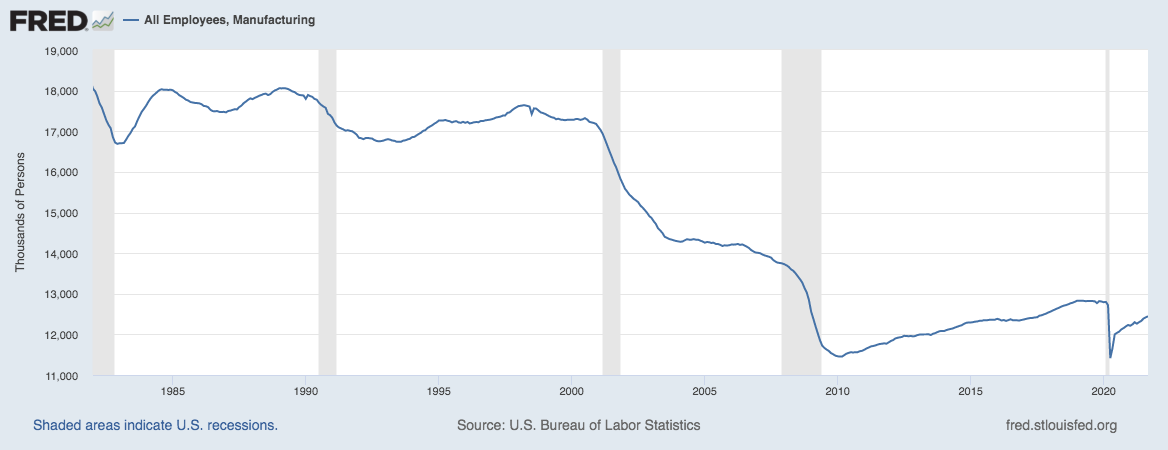Table of Contents
Manufacturing
(Topics: Private Sector | Back to Home)
It's time to face facts. The manufacturing industry in the United States will never be like what it was. In the 1940s and 1950s, 1 in 3 jobs were in factories. But today it's less than 1 in 10 jobs. And there are two big reasons why this has happened: outsourcing and automation.
We're all familiar with these concepts. Jobs have gone overseas because it's cheaper. And jobs have gone to robots because it's cheaper. This shouldn't surprise anyone.
What may surprise people is that the industry itself isn't actually declining. We continue to manufacture lots of stuff. But what we make is more complicated and more expensive than it used to be. You're less likely to own American-made products as an individual consumer (or work in an American factory). But we still produce a ton of stuff, especially for businesses and for the rest of the world.
Not "Bring Back", but "Move Forward"
The low-skill manufacturing jobs that used to be common in America will not be returning. This has been a long downward trend, and with a few bumps. That's a drop of 18 million down to 12 million jobs, and in the meantime the population has grown by 50%.

But what can and should continue to happen is high-tech manufacturing requiring highly skilled workers. This is what has happened to manufacturing: we are making better, more valuable products but with fewer people. The share of the economy that manufacturing makes up has been largely constant [1].
This is also an area where we currently lead the world and where there continues to be tremendous potential for further growth [2]. High-tech manufacturing is where we need to focus.
Financing is the challenge
How do we get more high-tech manufacturing? We need more factories. To quote journalist Robinson Meyer [4]:
| Perhaps the problem is simpler: The U.S. doesn’t have [much of] a high-end manufacturing sector because nobody will finance one. Small and medium-size American companies now struggle to borrow the billions of dollars necessary to finance a new factory, especially if those loans take 10 or 20 years to pay out. |
If there's a straightforward answer, it's stronger support to build these factories, and that can come through sound policy. This is something which Republicans like Marco Rubio support [5] and for which Senate Democrats have put together a specific proposal for a government-chartered bank [6]. These are ideas worth discussing. If we're going to continue to grow the manufacturing sector, there has to be the money to do it.
Manufacturing isn't what you think
Too often, the rhetoric is the lie that “we can bring manufacturing jobs back.” That's not true, and the truth is probably worse, which is the era of low-skill, high-paying jobs is over. More of us will need specialized training to compete and thrive in the economy of the future. And while millions of people will work to produce the goods the world wants and needs, there will be fewer people doing it on average.
We will grow. But we have to start with the truth.
[1] https://www.stlouisfed.org/on-the-economy/2017/april/us-manufacturing-really-declining